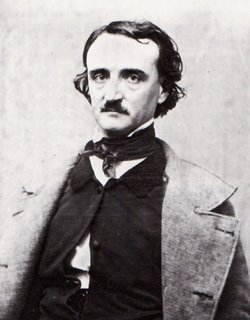
Heading into the weekend so I thought I would tone down a bit from all the hysteria and acrimony bouncing around the art web. Its come to my attention that we are all feeding off each other quite well in this bathysphere of art blogging but that we do too often sound like we are speaking for our own catharsis and perhaps forget why we all started blogging in the first place - catharthis !!!. Kidding, we're all speaking to each other for the purpose of the larger discussion on practice, ART PRACTICE and meaning in all its forms and frustrations.
I'm devouring a new book by the duo of Reiser + Umemoto called the Atlas of Novel Tectonics. Having just finished a wonderful brief encounter with Edgar Allan Poe and his thoughts on composition, I thought I would share with the studio in mind for anyone reading this.
Poe on Composition-
The consideration of effects over history and narrative:
There is a radical error, I think, in the usual mode of constructing a story. Either history affords a thesis - or one is suggested by an incident of the day... I prefer commencing with the consideration of an effect. Keeping originality always in view- for he is false to himself who ventures to dispense with so obvious and so easily attainable a source of interest - I say to myself , in the first place, "oh of the innumerable effects, or impressions, of which the heart, the intellect, or (more generally ) the soul, what one shall I, on the present occasion, select?Second, the establishment of complex repitition:
As commonly used, the refrain, or burden, not only limited to lyric verse, but depends for its impression upon the force of monotone- both in sound and thought. The pleasure is deduced soley from the sense of identity - of repitition. I resolved to diversify, and so vastly heighten, the effect, by adhering, in general, to the monotone of sound, while continually varied that of thought: that is to say, I determined to produce continuously novel effects, by the variation of the application of the refrain - the refrain itself remaining, for the most part, unvaried.Poe's discussion of composition begins with a mood (rhythm/refrain) which later acquires a narrative. Novel Tectonics elaborates further:
The refrain from The Raven, "nevermore" went into the poem before the raven did, in order to generate a certain tonal affect. The narrative came only later, at the end. Continuous variation within a homogenous refrain is also the means of modulating the possible duration of an effect. Variations in thought are generated around the same sound, changing its tone. "Nevermore" is like a zero and a one, it is objectively meaningless repitition read through in various narratives. It is an expression of a certain tone and intensity with variable emotional resonances projecting from it, including humor. "Nevermore" is the migration of the diagram.It is the speed or slowness which causes the diagram to have particular and emotional resonances of understanding as well as creative staying power. The diagram or tone is the template for the practice or the act itself, which allows the artist to compose and navigate with an endless range of emotive and intellectual particularity without getting too mired in the topical (contemporary) or historical (nostalgic). Poe is genious and certianly an Art for Art Sake guy, but I think this idea of a tonal centerpiece, an intensity strategy rather, is fascinating and bodes well for hard questioning within the studio practice. It allows one to discover complex variables derived from a simple and personal constant - whatever form that diagram may take, refrain, rhythm, sound, color, melancholy, humor, etc. It hints at finding an element(s) within a process that can be constantly mined without trying to reinvent the wheel everytime you confront making. This has tremendous value, and I would argue, frees the mind to really find new routes of discovery without getting dragged down by discourse fears and demands.






3 comments:
Ok, i read it again. I see now this is a good excuse for continuing to paint the same thing that I seriously have been painting for the past 5 years. Not even a shape anymore.
"I have often thought how interesting a magazine paper might be written by any author who would- that is to say, who could- detail, step by step, the processes by which any one of his compositions attained its ultimate point of completion." Not sure this would make a good blog piece, but it is sort of what I thought I was doing when I started mine in the first place.
I will only conclude with the happy thought that Poe, celebrity that he was, would think little of the celebro-centric scene we're confronting.
Nice job. I hope you'll dig out more from sources like this.
Well excuse is not what i had mind! Rather a locus that can serve as a regular heartbeat for multiple experience. I thin he is hinting at something which is central to meditation. You locate the field of observation, fixed but moving within and without that "field".
I'm not saying (or is Poe I believe) - embrace multiples -although that could be a strategy (Warhol)- but find a tone, the driving pulse or skeleton. Break it down to the simplest element then build on that.
All of teh complex ideas will naturally adhere to that simple sound element.
He was certainlt a stuntman in his own right but he bled poetry and wrote the 'famous' works to subsidize wht he thought was his art - the poem. Glad you like
Thanks
Post a Comment